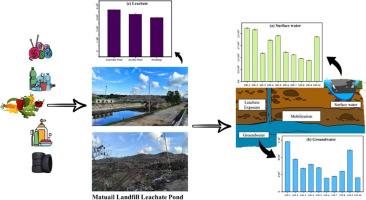垃圾填埋场渗滤液中微塑料的普遍性和分类:影响、风险和处理效率
IF 5.4
Q2 ENGINEERING, ENVIRONMENTAL
引用次数: 0
摘要
孟加拉国地表水和地下水中的微塑料 (MPs) 是一个重大问题。本研究的目的是评估垃圾填埋场沥滤液作为 MPs 潜在来源的可能性,并确定周围地表水 (SW) 和地下水 (GW) 是否作为接受者。此外,本研究还评估了渗滤液处理厂对 MP 的去除效果和 MP 风险评估。研究结果表明,马图艾尔垃圾填埋场渗滤液每小时向周围水生环境排放 3.5 × 108 个颗粒,平均浓度为 350 ± 10 MPs/L。在西南部发现的多孔微粒较多,然后是在西北部,平均分别为 1683 ± 70 MPs/L 和 614 ± 40 MPs/L,48.9%的多孔微粒介于 0.1 毫米至 0.5 毫米之间。主要形状为纤维和碎片。傅立叶变换红外光谱(FTIR)分析显示,低密度聚乙烯(LDPE)、高密度聚乙烯(HDPE)和聚丙烯(PP)最为常见,而聚氨酯(PUR)、聚甲基丙烯酸甲酯(PMMA)和聚丙烯腈(PAN)对环境的威胁最大。低效处理方法导致 83.33% 的 MPs 被释放,这表明渗滤液的去除效率较低。低效去除率导致 SW 的污染物负荷指数最高(2.18)。最终,对新污染指数 (NPI)、污染因子 (CF)、污染负荷指数 (PLI)、聚合物危害指数 (PHI) 和潜在生态风险 (Ei) 的分析表明,污染范围从极小到极大。通过主成分分析(PCA),发现了颗粒形状和大小之间的明显联系。此外,考虑到这种污染的严重性,它强调了对 MPs 进行持续的国家监测的必要性,并指出了对垃圾填埋场进行积极管理的重要性。本文章由计算机程序翻译,如有差异,请以英文原文为准。

Pervasiveness and classification of microplastics in Landfill Leachate: Impacts, risks, and treatment efficiency
Microplastics (MPs) in surface and groundwater in Bangladesh are a significant issue. The purpose of this research was to assess the possibility of landfill leachate acting as a potential origin of MPs and to determine if the surrounding surface water (SW) and groundwater (GW) act as recipients. Furthermore, this research assessed the leachate treatment plant MP removal efficacy and MP risk assessment. The findings show that discharge leachate from the Matuail landfill contributes 3.5 × 108 particles per hour to the surrounding aquatic environment, with an average of 350 ± 10 MPs/L. MPs were found highly in SW and then in GW with an average of 1683 ± 70 and 614 ± 40 MPs/L, respectively, with 48.9% of MPs ranging from 0.1 mm to 0 .5mm. The dominant shapes were fibers and fragments. The Fourier transform infrared spectroscopy (FTIR) analysis revealed low density polyethylene (LDPE), high density polyethylene (HDPE), and Polypropylene (PP) were the most common, and Polyurethane (PUR), Polymethyl methacrylate (PMMA), and Polyacrylonitrile (PAN) posed the greatest threat to the environment. The inefficient treatment method resulted in the release of 83.33% of MPs, indicating a low removal efficiency in the leachate. The inefficient removal rate leads to the highest pollutant load index for SW (2.18). Ultimately, the analysis of the nemerow pollution index (NPI), contamination factor (CF), pollution load index (PLI), polymer hazard index (PHI), and potential ecological risk (Ei), revealed a minimal to extremely high range of contaminations. A clear link was obsevered between the particles shape and size throught the principal component analysis (PCA). Moreover, it highlights the need for ongoing national surveillance of MPs considering the gravity of this contamination and indicates the importance of proactive management of landfill sites.
求助全文
通过发布文献求助,成功后即可免费获取论文全文。
去求助
来源期刊

Journal of hazardous materials advances
Environmental Engineering
CiteScore
4.80
自引率
0.00%
发文量
0
审稿时长
50 days
 求助内容:
求助内容: 应助结果提醒方式:
应助结果提醒方式:


